Abstract
A survey of the types of aerobic organisms able to produce H2S on peptone iron agar (Levin, 1968), and commonly occurring in meat and poultry plants, revealed that these could be divided into four distinct groups. The ability of representative strains of each type to grow at low temperatures and cause off-odors on chicken muscle was examined. The results are discussed in relation to the role of these organisms in the psychrophilic spoilage of meat and meat products.
Full text
PDF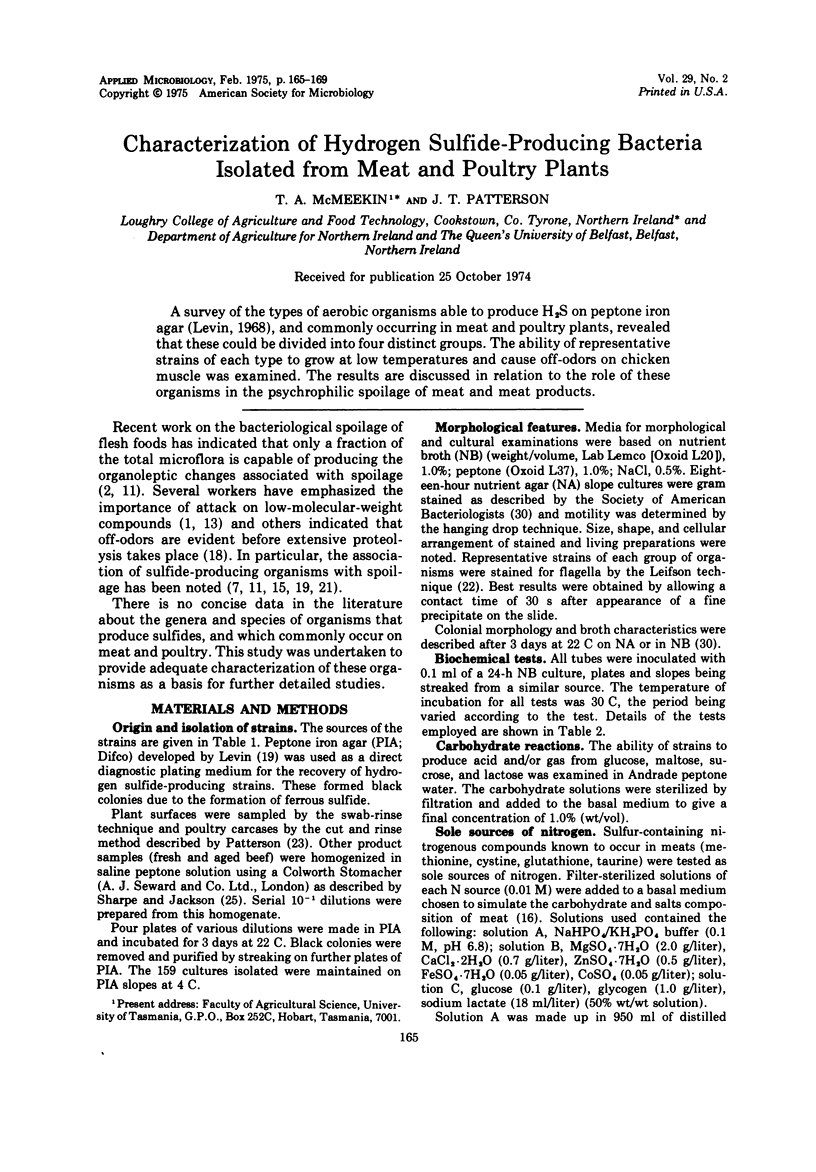
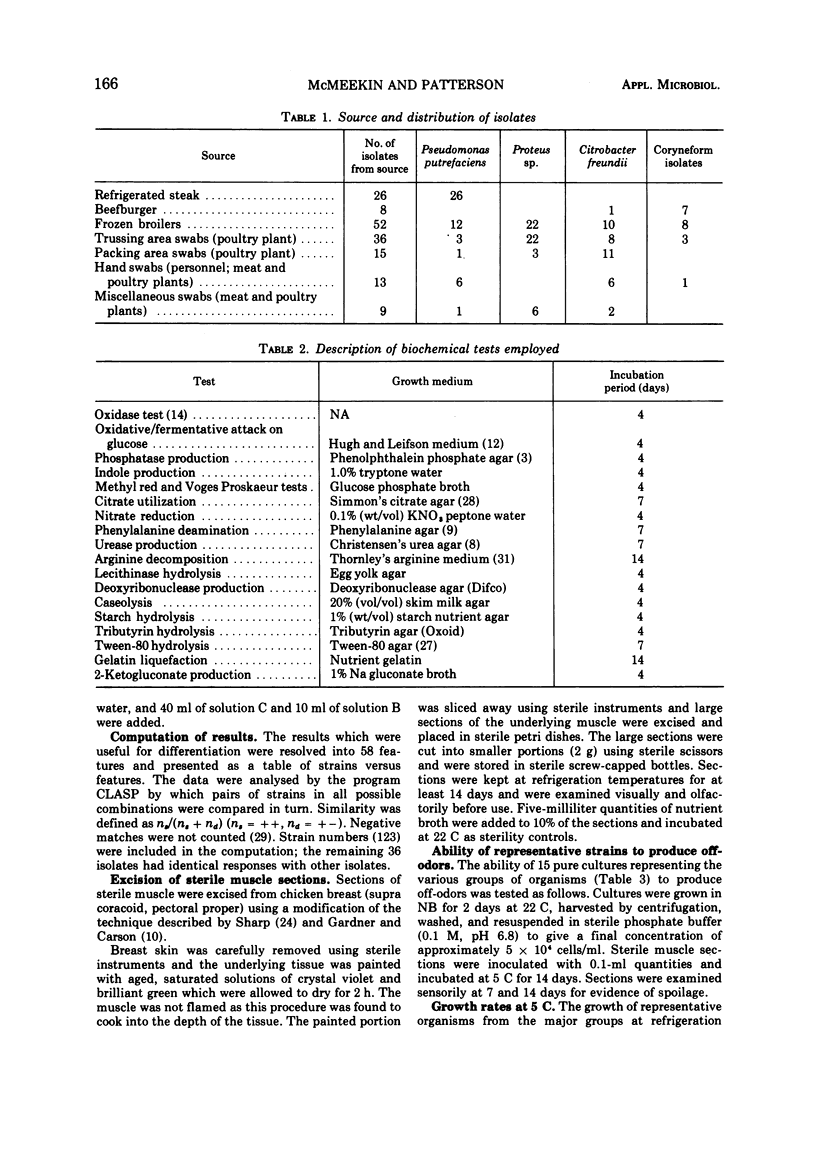
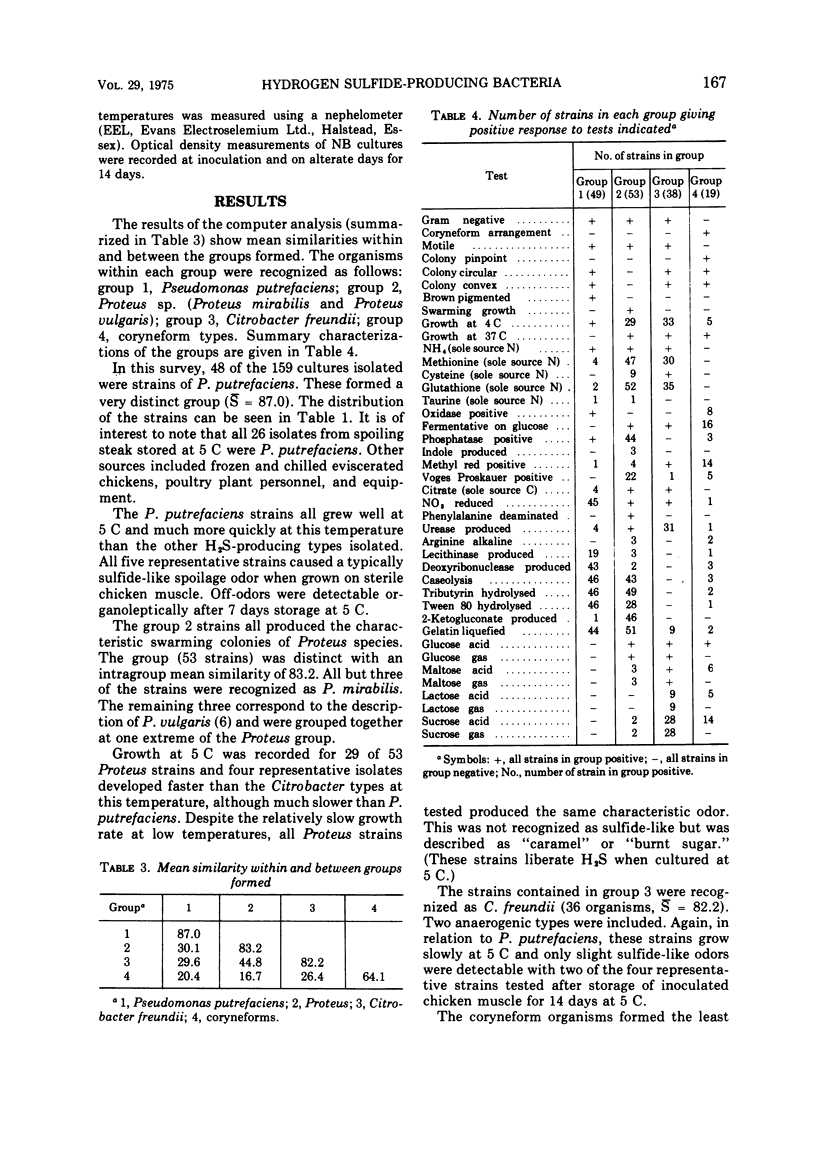
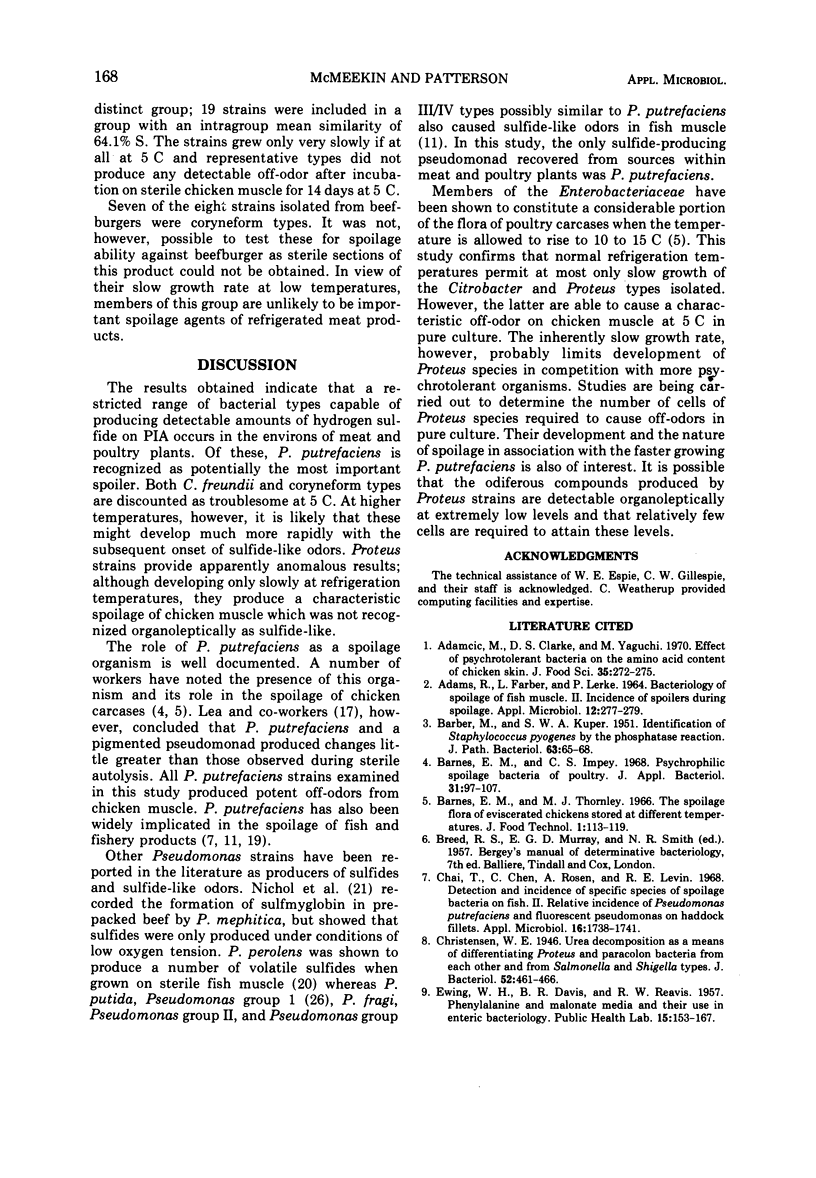
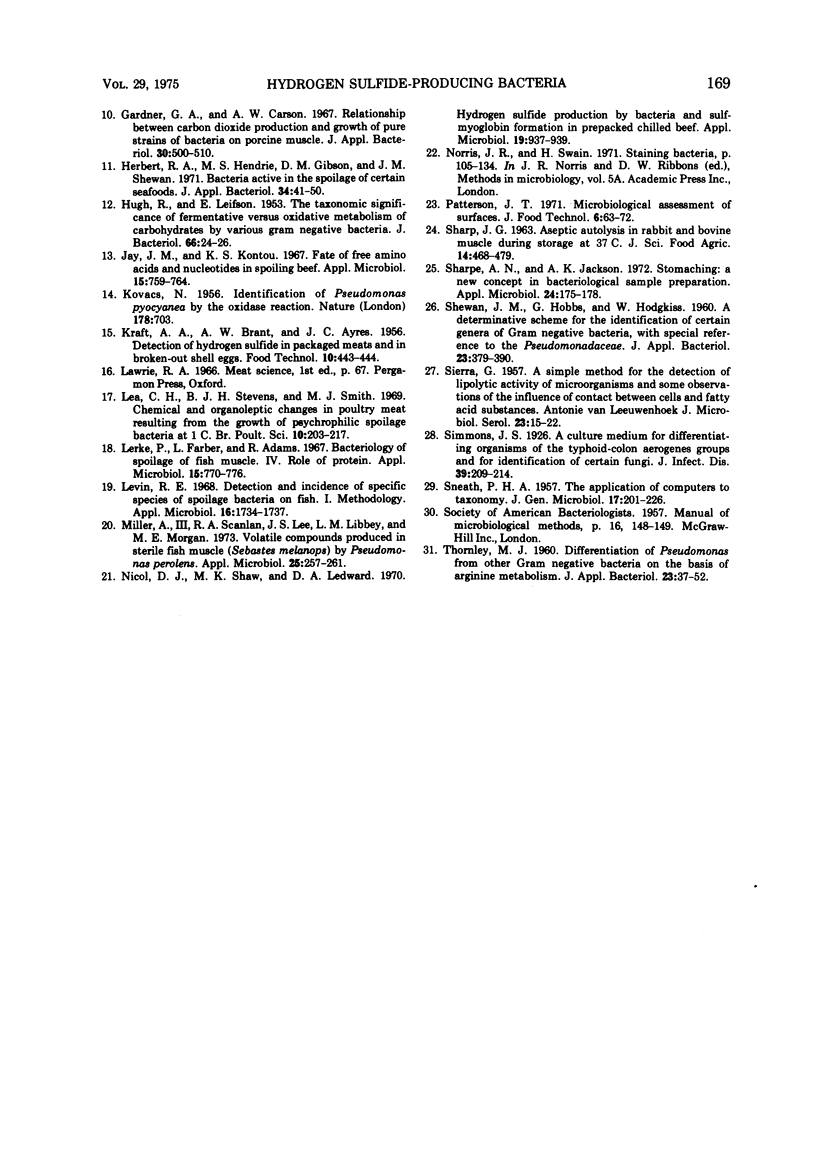
Selected References
These references are in PubMed. This may not be the complete list of references from this article.
- ADAMS R., FARBER L., LERKE P. BACTERIOLOGY OF SPOILAGE OF FISH MUSCLE. II. INCIDENCE OF SPOILERS DURING SPOILAGE. Appl Microbiol. 1964 May;12:277–279. doi: 10.1128/am.12.3.277-279.1964. [DOI] [PMC free article] [PubMed] [Google Scholar]
- BARBER M., KUPER S. W. A. Identification of Staphylococcus pyogenes by the phosphatase reaction. J Pathol Bacteriol. 1951 Jan;63(1):65–68. doi: 10.1002/path.1700630108. [DOI] [PubMed] [Google Scholar]
- Barnes E. M., Impey C. S. Psychrophilic spoilage bacteria of poultry. J Appl Bacteriol. 1968 Mar;31(1):97–107. doi: 10.1111/j.1365-2672.1968.tb00345.x. [DOI] [PubMed] [Google Scholar]
- Chai T., Chen C., Rosen A., Levin R. E. Detection and incidence of specific species of spoilage bacteria on fish. II. Relative incidence of Pseudomonas putrefaciens and fluorescent pseudomonads on haddock fillets. Appl Microbiol. 1968 Nov;16(11):1738–1741. doi: 10.1128/am.16.11.1738-1741.1968. [DOI] [PMC free article] [PubMed] [Google Scholar]
- Christensen W. B. Urea Decomposition as a Means of Differentiating Proteus and Paracolon Cultures from Each Other and from Salmonella and Shigella Types. J Bacteriol. 1946 Oct;52(4):461–466. doi: 10.1128/jb.52.4.461-466.1946. [DOI] [PMC free article] [PubMed] [Google Scholar]
- Gardner G. A., Carson A. W. Relationship between carbon dioxide production and growth of pure strains of bacteria on porcine muscle. J Appl Bacteriol. 1967 Dec;30(3):500–510. doi: 10.1111/j.1365-2672.1967.tb00329.x. [DOI] [PubMed] [Google Scholar]
- HUGH R., LEIFSON E. The taxonomic significance of fermentative versus oxidative metabolism of carbohydrates by various gram negative bacteria. J Bacteriol. 1953 Jul;66(1):24–26. doi: 10.1128/jb.66.1.24-26.1953. [DOI] [PMC free article] [PubMed] [Google Scholar]
- Herbert R. A., Hendrie M. S., Gibson D. M., Shewan J. M. Symposium on microbial changes in foods. Bacteria active in the spoilage of certain sea foods. J Appl Bacteriol. 1971 Mar;34(1):41–50. doi: 10.1111/j.1365-2672.1971.tb02267.x. [DOI] [PubMed] [Google Scholar]
- Jay J. M., Kontou K. S. Fate of free amino acids and nucleotides in spoiling beef. Appl Microbiol. 1967 Jul;15(4):759–764. doi: 10.1128/am.15.4.759-764.1967. [DOI] [PMC free article] [PubMed] [Google Scholar]
- KOVACS N. Identification of Pseudomonas pyocyanea by the oxidase reaction. Nature. 1956 Sep 29;178(4535):703–703. doi: 10.1038/178703a0. [DOI] [PubMed] [Google Scholar]
- Lea C. H., Stevens B. J., Smith M. J. Chemical and organoleptic changes in poultry meat resulting from the growth of psychrophylic spoilage bacteria at 1 degree C. I. Introduction and changes in free amino acids. Br Poult Sci. 1969 Jul;10(3):203–217. doi: 10.1080/00071666908415761. [DOI] [PubMed] [Google Scholar]
- Lerke P., Farber L., Adams R. Bacteriology of spoilage of fish muscle. IV. Role of protein. Appl Microbiol. 1967 Jul;15(4):770–776. doi: 10.1128/am.15.4.770-776.1967. [DOI] [PMC free article] [PubMed] [Google Scholar]
- Levin R. E. Detection and incidence of specific species of spoilage bacteria on fish. I. Methodology. Appl Microbiol. 1968 Nov;16(11):1734–1737. doi: 10.1128/am.16.11.1734-1737.1968. [DOI] [PMC free article] [PubMed] [Google Scholar]
- Miller A., 3rd, Scanlan R. A., Lee J. S., Libbey L. M., Morgan M. E. Volatile compounds produced in sterile fish muscle (Sebastes melanops) by Pseudomonas perolens. Appl Microbiol. 1973 Feb;25(2):257–261. doi: 10.1128/am.25.2.257-261.1973. [DOI] [PMC free article] [PubMed] [Google Scholar]
- Nicol D. J., Shaw M. K., Ledward D. A. Hydrogen sulfide production by bacteria and sulfmyoglobin formation in prepacked chilled beef. Appl Microbiol. 1970 Jun;19(6):937–939. doi: 10.1128/am.19.6.937-939.1970. [DOI] [PMC free article] [PubMed] [Google Scholar]
- SIERRA G. A simple method for the detection of lipolytic activity of micro-organisms and some observations on the influence of the contact between cells and fatty substrates. Antonie Van Leeuwenhoek. 1957;23(1):15–22. doi: 10.1007/BF02545855. [DOI] [PubMed] [Google Scholar]
- SNEATH P. H. The application of computers to taxonomy. J Gen Microbiol. 1957 Aug;17(1):201–226. doi: 10.1099/00221287-17-1-201. [DOI] [PubMed] [Google Scholar]
- Sharpe A. N., Jackson A. K. Stomaching: a new concept in bacteriological sample preparation. Appl Microbiol. 1972 Aug;24(2):175–178. doi: 10.1128/am.24.2.175-178.1972. [DOI] [PMC free article] [PubMed] [Google Scholar]


